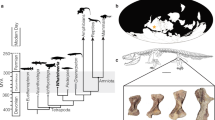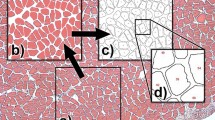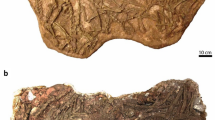Abstract
The wide diversity of skeletal proportions in mammals is evident upon a survey of any natural history museum's collections and allows us to distinguish between species even when reduced to their calcified components. Similarly, each individual is comprised of a variety of bones of differing lengths. The largest contribution to the lengthening of a skeletal element, and to the differential elongation of elements, comes from a dramatic increase in the volume of hypertrophic chondrocytes in the growth plate as they undergo terminal differentiation1,2,3,4,5,6,7. However, the mechanisms of chondrocyte volume enlargement have remained a mystery8,9,10,11. Here we use quantitative phase microscopy12 to show that mammalian chondrocytes undergo three distinct phases of volume increase, including a phase of massive cell swelling in which the cellular dry mass is significantly diluted. In light of the tight fluid regulatory mechanisms known to control volume in many cell types13, this is a remarkable mechanism for increasing cell size and regulating growth rate. It is, however, the duration of the final phase of volume enlargement by proportional dry mass increase at low density that varies most between rapidly and slowly elongating growth plates. Moreover, we find that this third phase is locally regulated through a mechanism dependent on insulin-like growth factor. This study provides a framework for understanding how skeletal size is regulated and for exploring how cells sense, modify and establish a volume set point.
This is a preview of subscription content, access via your institution
Access options
Subscribe to this journal
Receive 51 print issues and online access
$199.00 per year
only $3.90 per issue
Buy this article
- Purchase on Springer Link
- Instant access to full article PDF
Prices may be subject to local taxes which are calculated during checkout




Similar content being viewed by others
References
Wilsman, N. J., Farnum, C. E., Leiferman, E. M., Fry, M. & Barreto, C. Differential growth by growth plates as a function of multiple parameters of chondrocytic kinetics. J. Orthop. Res. 14, 927–936 (1996)
Hunziker, E. B., Schenk, R. K. & Cruz-Orive, L. M. Quantitation of chondrocyte performance in growth-plate cartilage during longitudinal bone growth. J. Bone Joint Surg. Am. 69, 162–173 (1987)
Hunziker, E. B. & Schenk, R. K. Physiological mechanisms adopted by chondrocytes in regulating longitudinal bone growth in rats. J. Physiol. (Lond.) 414, 55–71 (1989)
Breur, G. J., VanEnkevort, B. A., Farnum, C. E. & Wilsman, N. J. Linear relationship between the volume of hypertrophic chondrocytes and the rate of longitudinal bone growth in growth plates. J. Orthop. Res. 9, 348–359 (1991)
Kuhn, J. L., Delacey, J. H. & Leenellett, E. E. Relationship between bone growth rate and hypertrophic chondrocyte volume in New Zealand white rabbits of varying ages. J. Orthop. Res. 14, 706–711 (1996)
Wilsman, N. J., Bernardini, E. S., Leiferman, E., Noonan, K. & Farnum, C. E. Age and pattern of the onset of differential growth among growth plates in rats. J. Orthop. Res. 26, 1457–1465 (2008)
Farnum, C. E., Tinsley, M. & Hermanson, J. W. Forelimb versus hindlimb skeletal development in the big brown bat, Eptesicus fuscus: functional divergence is reflected in chondrocytic performance in autopodial growth plates. Cells Tissues Organs 187, 35–47 (2008)
Buckwalter, J. A., Mower, D., Ungar, R., Schaeffer, J. & Ginsberg, B. Morphometric analysis of chondrocyte hypertrophy. J. Bone Joint Surg. Am. 68, 243–255 (1986)
Farnum, C. E., Lee, R., O’Hara, K. & Urban, J. P. G. Volume increase in growth plate chondrocytes during hypertrophy: the contribution of organic osmolytes. Bone 30, 574–581 (2002)
Bush, P. G., Parisinos, C. A. & Hall, A. C. The osmotic sensitivity of rat growth plate chondrocytes in situ; clarifying the mechanisms of hypertrophy. J. Cell. Physiol. 214, 621–629 (2008)
Bush, P. G., Pritchard, M., Loqman, M. Y., Damron, T. A. & Hall, A. C. A key role for membrane transporter NKCC1 in mediating chondrocyte volume increase in the mammalian growth plate. J. Bone Miner. Res. 25, 1594–1603 (2010)
Barer, R. Interference microscopy and mass determination. Nature 169, 366–367 (1952)
Hoffmann, E. K., Lambert, I. H. & Pedersen, S. F. Physiology of cell volume regulation in vertebrates. Physiol. Rev. 89, 193–277 (2009)
Hunziker, E. B. Mechanism of longitudinal bone growth and its regulation by growth plate chondrocytes. Microsc. Res. Tech. 28, 505–519 (1994)
Kronenberg, H. M. Developmental regulation of the growth plate. Nature 423, 332–336 (2003)
Popescu, G., Ikeda, T., Dasari, R. R. & Feld, M. S. Diffraction phase microscopy for quantifying cell structure and dynamics. Opt. Lett. 31, 775–777 (2006)
Barer, R. Determination of dry mass, thickness, solid and water concentration in Living Cells. Nature 172, 1097–1098 (1953)
Cooper, K. L. The lesser Egyptian jerboa, Jaculus jaculus: a unique rodent model for evolution and development. Cold Spring Harb. Protocols 2011, pdb.emo066704 (2011)
Wang, J., Zhou, J. & Bondy, C. A. Igf1 promotes longitudinal bone growth by insulin-like actions augmenting chondrocyte hypertrophy. FASEB J. 13, 1985–1990 (1999)
Oldham, S. & Hafen, E. Insulin/IGF and target of rapamycin signaling: a TOR de force in growth control. Trends Cell Biol. 13, 79–85 (2003)
Yakar, S. Normal growth and development in the absence of hepatic insulin-like growth factor I. Proc. Natl Acad. Sci. USA 96, 7324–7329 (1999)
Lowe, L. A., Yamada, S. & Kuehn, M. R. HoxB6-Cre transgenic mice express Cre recombinase in extra-embryonic mesoderm, in lateral plate and limb mesoderm and at the midbrain/hindbrain junction. Genesis 26, 118–120 (2000)
Serrat, M. A., Lovejoy, C. O. & King, D. Age- and site-specific decline in insulin-like growth factor-I receptor expression is correlated with differential growth plate activity in the mouse hindlimb. Anat. Rec. (Hoboken) 290, 375–381 (2007)
Jordan, B., Vercammen, P. & Cooper, K. L. Husbandry and breeding of the lesser Egyptian jerboa, Jaculus jaculus. Cold Spring Harb Protocols 2011 http://dx.doi.org/10.1101/pdb.prot066712 (2011)
Maroudas, A. & Evans, H. A study of ionic equilibria in cartilage. Connect. Tissue Res. 1, 69–77 (1972)
Urban, J. P. G., Hall, A. C. & Gehl, K. A. Regulation of matrix synthesis rates by the ionic and osmotic environment of articular chondrocytes. J. Cell. Physiol. 154, 262–270 (1993)
Errington, R. J., Fricker, M. D., Wood, J. L., Hall, A. C. & White, N. S. Four-dimensional imaging of living chondrocytes in cartilage using confocal microscopy: a pragmatic approach. Am. J. Physiol. 272, C1040–C1051 (1997)
Lecine, P., Blank, V. & Shivdasani, R. Characterization of the hematopoietic transcription factor NF-E2 in primary murine megakaryocytes. J. Biol. Chem. 273, 7572–7578 (1998)
Shivdasani, R. A. & Schulze, H. Culture, expansion, and differentiation of murine megakaryocytes. Current Protocols Immunol. http://dx.doi.org/10.1002/0471142735.im22f06s67 (2005)
Acknowledgements
We would like to thank T. J. Mitchison, C. E. Farnum and members of the Developmental Bone Morphogenesis program project grant (National Institutes of Health (NIH)) for helpful discussions. We also thank the Nikon Imaging Center at Harvard Medical School for technical support, A. Luyten and R. Shivdasani for providing mouse megakaryocytes and P. Ramirez for jerboa care. This work was supported by NIH grants P01DK056246 to C.J.T.; R01GM026875 to M.W.K.; and by NIH grant P41RR02594, National Science Foundation (NSF) grant DBI0754339 and support from the Hamamatsu Corporation to R.R.D.
Author information
Authors and Affiliations
Contributions
K.L.C. and S.O. conceived the project and carried out most of the experiments. Y.S. and R.R.D. carried out critical tomographic experiments validating the primary approaches taken. C.J.T. and M.W.K. supervised the project. K.L.C., S.O., M.W.K. and C.J.T. wrote the manuscript.
Corresponding author
Ethics declarations
Competing interests
The authors declare no competing financial interests.
Supplementary information
Supplementary Information
This file contains Supplementary Figures 1-14, Supplementary Methods, and Data , Supplementary Table 1 and Supplementary References. (PDF 3883 kb)
Rights and permissions
About this article
Cite this article
Cooper, K., Oh, S., Sung, Y. et al. Multiple phases of chondrocyte enlargement underlie differences in skeletal proportions. Nature 495, 375–378 (2013). https://doi.org/10.1038/nature11940
Received:
Accepted:
Published:
Issue Date:
DOI: https://doi.org/10.1038/nature11940
This article is cited by
-
The emerging studies on mesenchymal progenitors in the long bone
Cell & Bioscience (2023)
-
Nutrient-regulated dynamics of chondroprogenitors in the postnatal murine growth plate
Bone Research (2023)
-
Mapping nanoscale topographic features in thick tissues with speckle diffraction tomography
Light: Science & Applications (2023)
-
Probing the communication patterns of different chondrocyte subtypes in osteoarthritis at the single cell level using pattern recognition and manifold learning
Scientific Reports (2023)
-
The Origin and Fate of Chondrocytes: Cell Plasticity in Physiological Setting
Current Osteoporosis Reports (2023)
Comments
By submitting a comment you agree to abide by our Terms and Community Guidelines. If you find something abusive or that does not comply with our terms or guidelines please flag it as inappropriate.



